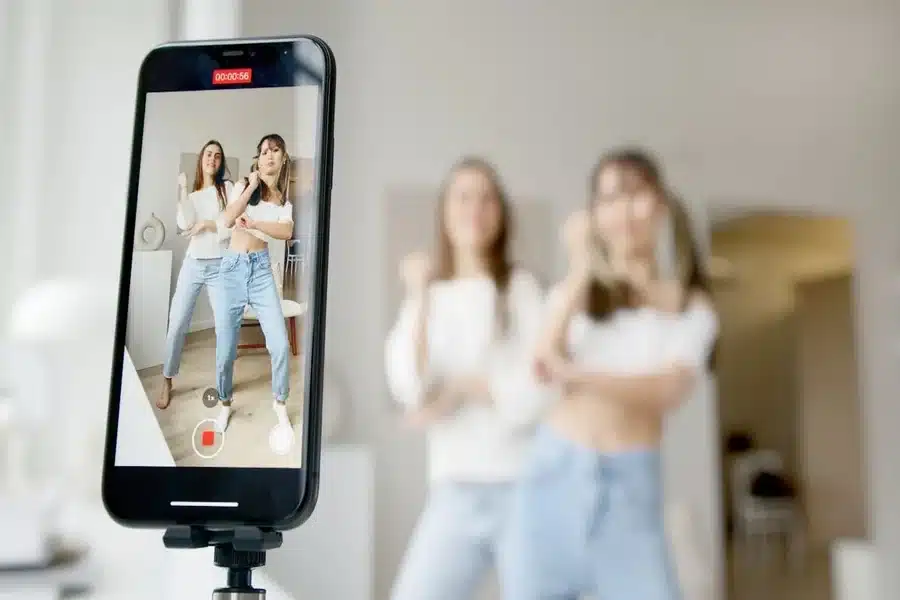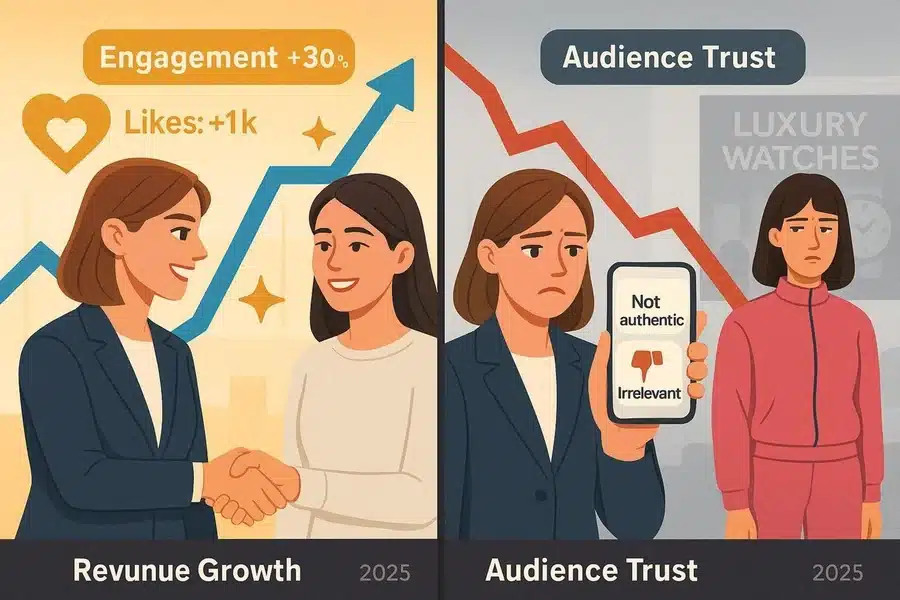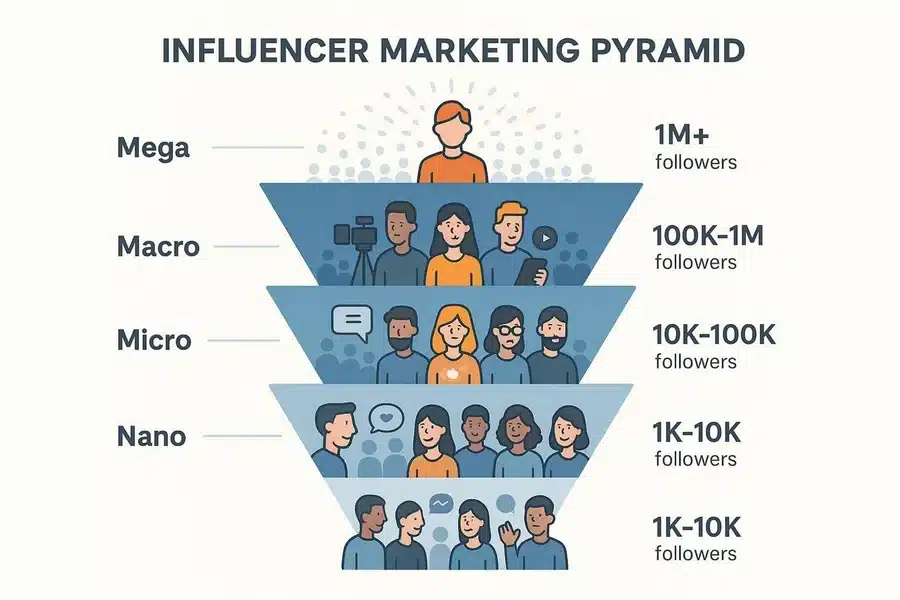How to Find the Right Influencer for Your Brand

In today’s busy online space, where people often doubt traditional ads, the real question is how to find the right influencer for your brand. The best path is a careful plan that puts real fit, honesty, and human connection ahead of follower counts.
Pick partners whose values and audience match your brand, and you can tell strong stories and spark real engagement that helps your bottom line.
Influencer marketing has changed a lot in the last decade. It’s no longer just celebrities; it now includes many types of creators with loyal followers. These creators can make brands feel more human and relatable.
In the 2024 Influencer Marketing Report, almost half of 2,000 consumers said they make daily, weekly, or monthly purchases because of influencer posts. To work in this fast space well, and to keep your message with trusted voices, add strong social media management tactics that include careful influencer checks.
Why Is It Important to Choose the Right Influencer?
Picking the right influencer is a key step for any campaign. It’s not just getting seen; it’s getting seen by the right people, in the right way, with the right message. The internet is crowded, and people are smarter about marketing, so honest connections matter more than ever.
Used well, influencer marketing is a powerful tool. It helps brands cut through noise and connect on a personal level. The goal is to use a creator’s trusted voice to build your brand’s good name, boost reach, and share your main messages clearly.
How the Wrong Influencer Can Affect Brand Goals
Partnering with a poor fit can hurt your goals and even your reputation. If a brand mention feels fake or values don’t match, people notice. For example, an eco-friendly brand working with someone who promotes fast fashion sends mixed signals and weakens the brand’s core message.
Beyond reputation, the wrong choice wastes budget and time. If their audience doesn’t match your target group, your message will miss, and results will fall short. Skipping research on their reputation, audience data, and real engagement can be costly.
Benefits of Working with the Right Influencer
The right partner can lead to strong results. When values and audiences line up, you get honest storytelling and trusted engagement. That means higher awareness, better targeting, and more conversions.
The right influencer acts like a trusted guide, bringing your brand to new people who already believe in their advice. This social proof helps move buyers to act. Good fits also support long-term work, where influencers become real brand partners who weave your product into their content. Over time, this builds recall and loyalty.

What Makes an Influencer the Right Fit for Your Brand?
Finding the right fit is more than follower numbers. You need to look closely at traits that show real alignment between the creator, their audience, and your goals.
An influencer is someone with a loyal following who can guide buying choices in a niche or industry, often with clear knowledge or insight on a topic.
Knowing the main influencer types and what each brings helps you match your plan to your goal, whether you want wide awareness or precise conversions.
Types of Influencers by Audience Size
Creators are often grouped by follower count. This affects reach, engagement style, and cost. These labels help, but quality beats quantity.
| Type | Followers | Reach Focus | Engagement Trend | Typical Cost | Best For |
| Mega | 1M+ | Mass reach | Lower rates on average | High | Big awareness pushes |
| Macro | 100K-1M | Large niche reach | Moderate to good | Medium to high | Broad niche campaigns |
| Micro | 10K-100K | Focused reach | Often higher | Medium | Targeted awareness and conversions |
| Nano | <10K | Local or tight community | Often very high | Low | Local/small-budget, niche moves |
Mega influencers
Mega influencers have over a million followers. This group includes stars like actors, musicians, athletes, and big social media names. For example, Helen Christie, a UK creator and actor, has nearly two million TikTok followers and one million YouTube subscribers, and has worked with brands such as Disney+ and Meta.
Mega influencers bring huge reach but also high costs. They suit brands with wide appeal and large budgets aiming for big awareness, not narrow targeting. Engagement rates can be lower due to broad audiences.
Macro-influencers
Macro-influencers have 100,000 to one million followers. They are known voices in set niches like food, beauty, or lifestyle. Mattie James, an Atlanta lifestyle creator, has teamed up with Samsung and Kroger.
They offer scale and often charge more, but their niche reach helps brands hit large, defined groups. For a brand focused on Black millennial moms and skincare, Mattie James is a strong pick.
Micro-influencers
Micro-influencers have 10,000 to 100,000 followers. They often see higher engagement, so their fans are more likely to notice and interact. They also tend to be more budget-friendly.
Serena Lalani, a Montreal-based vlogger with 16,000+ TikTok followers, is a good example. She has worked with brands like Murad Skincare and shows the value of real ties inside a community.
Nano-influencers
Nano-influencers have under 10,000 followers. While small in size, they often have tight bonds with their audience. This makes them great for reaching specific groups at low cost.
Danica Nelson, a Canadian finance and travel creator who has partnered with Mydoh and Rakuten, shows how nano creators can help local and small brands, or craft makers aiming at narrow niches.
What Is a Lookalike Influencer?
A lookalike influencer shares traits with another creator who already works well for your brand or a competitor. Shared traits might include content style, audience data, niche, or engagement style. Brands use lookalikes to scale wins to similar groups or repeat past success. Once you find a strong partner, finding “lookalikes” helps you grow your reach inside a proven segment.
Which Criteria Should You Use to Select Influencers?
Good selection means looking past surface metrics and checking the drivers of real influence. You want more than a popular account; you want a partner who can move people to act.
Influence and Reach
Influence and reach matter, but they need careful review. Reach is how many people can see content, often tied to follower count. Today, the focus is less on big totals and more on reaching the right people. Check followers across channels, views, and actions (likes, comments, shares). Big numbers help awareness, but for better ROI, pick creators who reach people who match your target.
Also watch posting habits. A high follower count with little content likely won’t help. Choose creators who post often over time; this shows they know their audience and treat their work seriously.
Engagement Quality and Authenticity
Engagement quality often says more than follower totals. High engagement shows an active audience. Look at likes, comments, and shares-but check the quality. Good comments are specific and on-topic. A high like count can be a vanity metric; thoughtful comment threads and lots of shares tell a better story.
Authenticity builds trust. People value creators who are open and real, and they trust their advice more. The creator should truly like your brand and fit it naturally. Over-controlling their content can make posts feel scripted and weak.
Brand Alignment and Shared Values
Your chosen influencer should feel like a natural extension of your brand. Their tone, look, and values should match your identity. If you sell ethical clothing, teaming with a fast fashion promoter is a mismatch and can damage your image. The closer the match, the more honest and effective the work will be.
This is about more than avoiding bad fits. A shared mission makes the partnership smoother and more meaningful. With that confidence, you can give creative space and still feel safe that their content will reflect your message.
Audience Demographics and Relevance
Knowing an influencer’s audience is non-negotiable. Your campaigns target specific groups. If their followers don’t match those groups, budget gets wasted.
Study your ideal customers: age, gender, location, interests, habits, and problems. Then pick creators whose followers match. If you target fitness fans, an athlete like Mariah Bell-with 100,000+ engaged fitness followers-beats a general lifestyle creator with a bigger but less relevant audience.
Credibility and Reputation
A creator’s public image reflects on your brand. Before you partner, check that they keep a positive record and avoid controversy that could hurt you. Review their content for ad disclosures, ethics, and rule compliance.
If a creator claims expert status, check credentials. A big audience with weak engagement or empty comments may signal trouble. High-performing creators show steady engagement, solid content volume, and a healthy bond with followers.
A 2019 study even found people trusted creators more when they followed fewer accounts than those who followed them, which hinted at real influence.
What Steps Help Define Your Ideal Influencer Profile?
Before you start searching, build a clear picture of your ideal influencer. This saves time and keeps choices aligned with your marketing goals. Think of it like a blueprint for a great brand partner.
Know Your Target Audience
Everything starts with your own audience. Who do you want to reach? What are their demographics, interests, habits, and pain points? When you know your audience well, you can pick creators whose followers and channels match. This makes it easier for your message to land.
For example, a fitness brand like Athleta will do better with an athlete who shares training content. That content fits the brand and connects with fitness fans who already care about the topic. That fit adds trust to the creator’s advice.
Set Clear Campaign Goals
Before you start outreach, set your goals. Do you want awareness, leads, sales, or a better brand image? Your goals guide the creator’s niche, content style, and platform choice.
For awareness, pick creators with broad reach and high engagement. For leads or sales, pick creators with a tight, trusting audience and proof they can drive action. Clear goals also help you set KPIs early so you can measure results and adjust with data later.
Create an Ideal Influencer Persona
After you map your audience and goals, turn that into an “ideal influencer persona.” List traits, audience data, content style, and engagement patterns. Add metrics like target follower range, engagement rate, and examples of past brand work that fit your vision.
This acts like a filter so you can narrow choices and focus outreach. You’re not just picking a name-you’re choosing a voice and audience that fit your brand and goals, leading to honest and effective work.
How Can You Find Relevant Influencers for Your Brand?
The internet is huge, and finding strong matches can feel hard. With the right tools and habits, you can quickly spot creators who matter to your brand and audience. Use tech, plus sharp observation.
Influencer Marketing Platforms and Tools
Influencer platforms help you find and manage creators. Many include advanced search filters and social insights to speed up discovery.
These tools can show topics a creator talks about most, give a “Brand Fit” view of content match, and offer benchmarks to compare creators. Brand safety checks protect your name, and affinity tools use machine learning to spot creators who already like similar brands. These features make the process easier for both pros and newcomers.
Native Social Media Searches
Built-in platform search is powerful. Use keywords and hashtags tied to your product or niche to find creators already posting in your space. An ethical clothing brand on TikTok might search #sustainablefashion.
On Instagram, location hashtags help you find local creators. Mix your city, niche, and terms like “influencer,” “creator,” “blogger,” or “vlogger” (e.g., #atlantamomblogger). On LinkedIn, search keywords and filter by “Posts” to find active experts with strong reach.
Competitor and Industry Analysis
Watch competitors to spot useful patterns. You may not hire the same people, but you can study who they work with and who engages with them. Check who gets lots of likes and comments on their posts-those people may also be good fits.
Scan wider industry trends too. Track viral posts to see who is getting traction and if they have active followers. Comment sections on big posts can reveal creators already part of key conversations.
Leveraging Your Existing Network
Great leads may be close by. Ask coworkers, employees, friends, peers, and partners for creator referrals that fit your brief. Post about your search and invite tags or DMs.
Join niche communities on Reddit or in Facebook and LinkedIn Groups. Look for top posters or moderators with positive engagement whose opinions carry weight. Engage with them in real ways-comment, share, and build rapport-so your outreach feels natural.
How to Discover Influencers on Different Platforms
Each platform has its own style and audience, so your search method should match. What works on TikTok may not work on LinkedIn.
Finding Influencers on Instagram
Instagram is a popular hub for creators and a solid starting point. While it skews younger, you can reach most groups. Start with location hashtags or mix your city, niche, and terms like “influencer” or “creator.”
After you find options, follow them, leave thoughtful comments, and research them on other channels and Google. When you’re ready to pitch, send a private DM or email-never post a public offer in comments.
Finding Influencers on TikTok
TikTok is growing fast with Millennials and Gen Z. Its editing tools make content feel real and casual, which younger viewers like. Search hashtags tied to your niche, such as #sustainablefashion for an ethical brand.
Follow creators, like and comment in a positive way, and study their style and audience. As on Instagram, keep partnership pitches private via DM.
Finding Influencers on YouTube
YouTube hosts many strong video creators, often skilled at high-quality production. These creators tend to have very engaged audiences, so a good match can deliver big results. Search for channels tied to your product or niche.
Subscribe, leave thoughtful comments, and check their other platforms. Most channels have an About tab with a business email for private outreach. Avoid public collaboration offers in video comments.
Finding Influencers on LinkedIn
LinkedIn is great for B2B work with experts and industry leaders. Use search with your keywords and filter by “Posts.” Look for posts with high engagement (likes, comments, views), which signals a strong audience. A search for “SEO” might reveal a marketer with tens of thousands of active followers.
Follow or connect, engage with their posts, and review their background. Start partnership talks privately by DM or email to keep it professional.
What Mistakes Should You Avoid in the Influencer Selection Process?
Good intentions can still lead to common errors. Avoiding these helps your campaigns perform better and protects your brand.
Focusing Only on Follower Count
Chasing big follower counts is a classic trap. Large audiences don’t always mean real impact. Some followers are inactive-or even fake-and won’t help your goals.
Pick creators with loyal, active fans, no matter the size. A smaller, trusting audience that listens is worth more than a large, passive one. Review engagement rates and comment quality to judge true influence.
Ignoring Engagement Insights
Another mistake is skipping engagement checks. A strong engagement rate signals real interest. Don’t stop at likes-study comments and shares. Are comments thoughtful and specific, or generic and spam-like?
Top creators often host meaningful conversations and see lots of shares. If interactions look shallow or fake, that’s a warning sign. These checks help you sort real connection from empty numbers.
Neglecting to Research Influencer Reputation
When you partner with a creator, their image affects yours. Skipping a background check can lead to trouble. Past issues, weak ethics, or fake practices can hurt your credibility by association.
Do a thorough review. Look at past content for value match, check ad disclosures, and confirm they follow rules and ethics. A poor values match or a pattern of bad behavior can quickly erode trust.
Overlooking Audience Demographics
Skipping audience data is another big error. If their followers don’t match your target groups, your message won’t land and your budget goes to waste.
Before you agree to work together, check age, gender, location, interests, and buying habits. Make sure their followers could be your customers. Selling to Gen Z? A creator whose audience is mostly Gen X won’t be a good spend. Precise targeting helps your message reach the right people in the right voice.
Key Takeaways for Finding and Partnering with the Right Influencer
Finding the right influencer is a key step, and the job continues after discovery. Aim to build honest, long-term partnerships that go beyond one-off posts. Think of it as co-creation, where the influencer becomes a true part of your brand voice.
Long-term work gives creators room to blend your brand into their content over time. This steady presence builds trust and recall, which improves loyalty. When a creator is part of your ongoing story, their content feels like a real recommendation, not an ad. This helps them grow into ambassadors who support both awareness and lead generation across many months.
Influencer marketing keeps changing, so focus on authenticity, clear communication, and shared goals to keep your edge.

